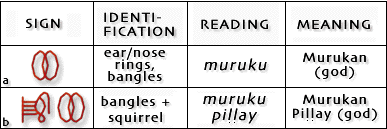The Planets
'Bangles' Sign: God Murukan
 Fig. 3: Bangles and Squirrel Sign
Fig. 3: Bangles and Squirrel Sign
The principal deity of early Tamils was Murakan, the youthful god of war and love, who became identified with the North Indian war-god Skanda. Parpola has identified the sign depicting a pair of intersecting circles (Fig. III a) as 'ear/nose rings' or 'bangles', muruku in Dravidian, which by rebus represents the god muruku (Murukan = Skanda) in the Indus texts.
The sign of intersecting circles can well depict a pair of bangles. There is also the solid evidence recently unearthed of quantities of stoneware bangles from Mohenjo-daro, many of them inscribed. Parpola points out that the sign of intersecting circles occurs with disproportionately high frequency on the bangle inscriptions. The rebus proposed by him is also exact.
If in spite of all this, there is a nagging doubt about the correctness of the reading, it is due to the fact that muruku is not the appropriate word for stoneware bangles. The word muruku is derived from the verbal root *mur/mur-V which has the specific meaning, 'to twist, be twisted'; (e.g.) murige (Kannada), 'twisting, a twist'; murige (Tulu), 'a twist'; murutaka (Malayalam), 'to pluck by twisting'. In fact the ear-ring or nose-ring known as muruku is made from twisted silver wire as one would expect from the etymology of the word; (e.g.) murugu (Kannada), 'a wire ring used as ornament for the nose and the ear'. The name muruku can be applied to a bangle or bracelet only if it is made of twisted metal or wire; (e.g.) murgi (Tulu), 'twisted bangle or bracelet made of silver'. Even assuming that the word muruku came to be used for all types of bangles by extension of meaning, this is unlikely to have happened at the Proto-Dravidian stage. In view of this linguistic discrepancy one hesitates to accept the proposed rebus. Except for its occurrence on bangles where this sign may have a literal meaning, there is no indication in other contexts that it represents a divinity.
